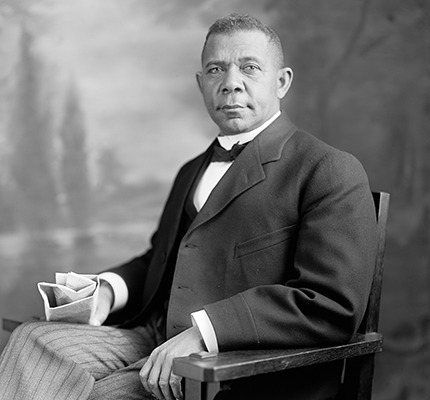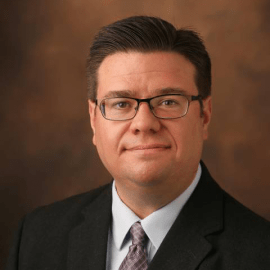
Exploring the “Rhetoric of Hands”: A Closer Look at Booker T. Washington’s Atlanta Exposition Address
Booker T. Washington went from being a slave, to an educator and first leader of the Tuskegee Institute, to one of the most powerful African-American orators in history. But his 1895 address at the Atlanta Exposition led to decades of scholarly criticism that reflect poorly on his legacy. In a new article in NCA’s Quarterly Journal of Speech, Paul Stob of Vanderbilt University argues for reconsideration of Washington’s rhetoric from this speech, which features recurring references, literal and figurative, to black hands.
Stob’s analysis focuses on one key phrase from Washington’s Atlanta address, where he spoke to thousands of whites and blacks alike: “In all things that are purely social, we can be as separate as the fingers yet one as the hand in all things essential to mutual progress.” The immediate response was thunderous applause, but in the days, weeks, and decades to follow, critics and rhetoricians declared the statement to be “an apparent endorsement of racial separation in favor of economic opportunity,” and “[seemed] to agree that Washington accepted and accommodated the very power structure he should have been fighting.”
In all things that are purely social, we can be as separate as the fingers yet one as the hand in all things essential to mutual progress.
Not so fast, says Stob. He suggests that critics have overlooked “the nuances and strategic sophistication of Washington’s oratory, which was more provocative, combative, and resistive than scholars have yet recognized.” He employs two arguments to support this idea; one focuses on the metaphor and meaning of hands, and the other on the role geography played in Washington’s address.
The Rhetoric of Hands
Frequently speaking about hands was risky for Washington, Stob writes, because of the connotations with slave labor. But Washington found a way to reach African Americans, especially those in the South who were feeling the constraints of racism and violence, by evoking a provocative symbolism of the body. “[Hands’] dynamism can signify an incredible amount of energy and potential in the body’s economy of signs,” Stob explains. “The hands have a distinct power to challenge the structures that have already imposed meaning upon people.”
To white listeners in the South, Washington’s statement about black hands “implied a continuation of the social order,” but to African Americans, who needed to remake meaning now that they were freed from the shackles of slavery and menial labor, black hands could be seen as a symbol of resistance and confrontation of the status quo. Stob explains that Washington deployed [hands] as “both literal and figurative markers of black empowerment,” and that he used terms “that extended from the work of hands – pushing and pulling, grabbing and grasping, holding and handling, dragging down and lifting up” – that not only engaged whites but also invited African Americans in the South “into a culture of active participation.”
In this speech and others, Washington frequently drew on references to hands to express his philosophy of education, saying that “the education of all the people, in heart, head, and hand, will be the solution of all the trying problems that surround and confront this southland.” Stob acknowledges an element of naiveté in this, but argues that for many blacks in the South, the idea of powerful black hands “offered a corrective to the sense of emasculation and displacement that had long defined their lives.” While whites would hear Washington promoting menial, service-oriented, socially marginalized labor, blacks would hear “‘hands as a marker of opportunity – a chance to work for themselves, to create their own lives, to become agents in their world.”
Why Atlanta Matters
The second part of Stob’s essay returns to the location of Washington’s address – the Atlanta Exposition. How does geography figure into the analysis of the speech?
Stob provides background on the arrangements of the Exposition, which followed a racially tense and exclusive expo in Chicago two years before. He notes that African Americans were asked to participate in the planning process, and that Washington was the first African-American speaker in the South to share a stage with whites at a national event. The stakes were high.
Given that “black political activism became closely associated with Northern urban communities” during the end of Reconstruction into the start of the 20th century, Stob notes that “urban-centered paradigms exacerbated already prevalent perceptions of Southerners.” Southerners were perceived to be lazy and diseased, and black men in particular were thought to be passive, pathological, and deviant. According to Stob, “Whatever the ultimate effectiveness of Northern urban activism, the discourse of race pride was unlikely to connect with rural black Southerners, especially given differences in education, class, and geography.”
That’s where the hands references came into play. Washington used another, extended metaphor about two ships at sea trying to signal to each other, and failing each time. He then applied the story to the current struggle between blacks and whites in the South, emphasizing trust, hands, and labor over a preoccupation with appearance and skin color. He added in his “education of head, hand, and heart” philosophy and touted Tuskegee.
Stob concludes that Washington’s active voice and strategic dichotomy sent a message to both blacks and whites in the South – and it wasn’t that hands could be the solution to all the violence and injustice. Instead, Washington had found a way to reach the rural African Americans that Stob says were often passed over in the push for civil rights. His ultimate message: “Black hands…could pull with the nation, or they could pull against white society. In short, they could resist.”


